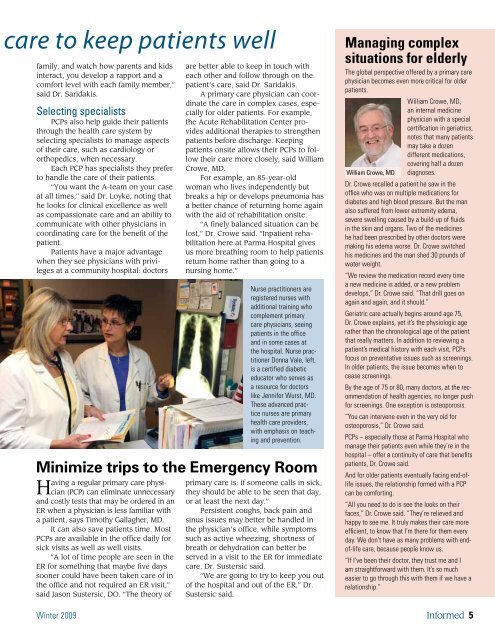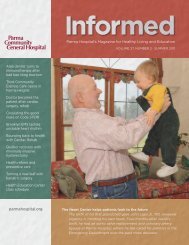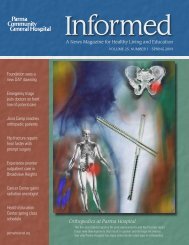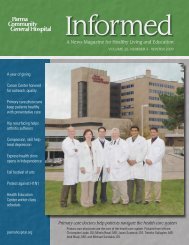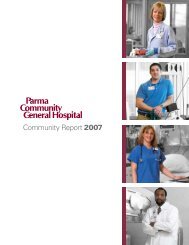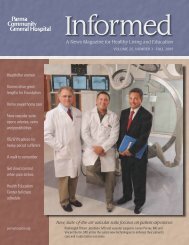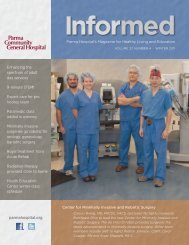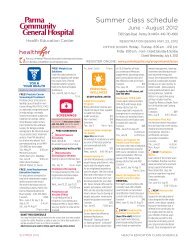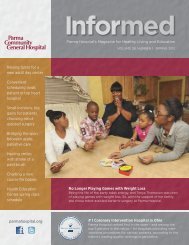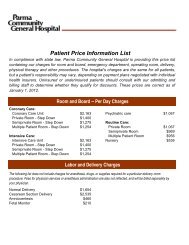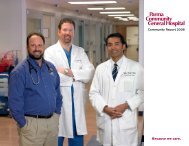Informed Magazine - Winter 2009.pdf - Parma Community General ...
Informed Magazine - Winter 2009.pdf - Parma Community General ...
Informed Magazine - Winter 2009.pdf - Parma Community General ...
You also want an ePaper? Increase the reach of your titles
YUMPU automatically turns print PDFs into web optimized ePapers that Google loves.
care to keep patients well<br />
family, and watch how parents and kids<br />
interact, you develop a rapport and a<br />
comfort level with each family member,”<br />
said Dr. Saridakis.<br />
Selecting specialists<br />
PCPs also help guide their patients<br />
through the health care system by<br />
selecting specialists to manage aspects<br />
of their care, such as cardiology or<br />
orthopedics, when necessary.<br />
Each PCP has specialists they prefer<br />
to handle the care of their patients.<br />
“You want the A-team on your case<br />
at all times,” said Dr. Loyke, noting that<br />
he looks for clinical excellence as well<br />
as compassionate care and an ability to<br />
communicate with other physicians in<br />
coordinating care for the benefit of the<br />
patient.<br />
Patients have a major advantage<br />
when they see physicians with privileges<br />
at a community hospital: doctors<br />
are better able to keep in touch with<br />
each other and follow through on the<br />
patient’s care, said Dr. Saridakis.<br />
A primary care physician can coordinate<br />
the care in complex cases, especially<br />
for older patients. For example,<br />
the Acute Rehabilitation Center provides<br />
additional therapies to strengthen<br />
patients before discharge. Keeping<br />
patients onsite allows their PCPs to follow<br />
their care more closely, said William<br />
Crowe, MD.<br />
For example, an 85-year-old<br />
woman who lives independently but<br />
breaks a hip or develops pneumonia has<br />
a better chance of returning home again<br />
with the aid of rehabilitation onsite.<br />
“A finely balanced situation can be<br />
lost,” Dr. Crowe said. “Inpatient rehabilitation<br />
here at <strong>Parma</strong> Hospital gives<br />
us more breathing room to help patients<br />
return home rather than going to a<br />
nursing home.”<br />
Nurse practitioners are<br />
registered nurses with<br />
additional training who<br />
complement primary<br />
care physicians, seeing<br />
patients in the office<br />
and in some cases at<br />
the hospital. Nurse practitioner<br />
Donna Vale, left,<br />
is a certified diabetic<br />
educator who serves as<br />
a resource for doctors<br />
like Jennifer Wurst, MD.<br />
These advanced practice<br />
nurses are primary<br />
health care providers,<br />
with emphasis on teaching<br />
and prevention.<br />
Minimize trips to the Emergency Room<br />
Having a regular primary care physician<br />
(PCP) can eliminate unnecessary<br />
and costly tests that may be ordered in an<br />
ER when a physician is less familiar with<br />
a patient, says Timothy Gallagher, MD.<br />
It can also save patients time. Most<br />
PCPs are available in the office daily for<br />
sick visits as well as well visits.<br />
“A lot of time people are seen in the<br />
ER for something that maybe five days<br />
sooner could have been taken care of in<br />
the office and not required an ER visit,”<br />
said Jason Sustersic, DO. “The theory of<br />
primary care is: if someone calls in sick,<br />
they should be able to be seen that day,<br />
or at least the next day.”<br />
Persistent coughs, back pain and<br />
sinus issues may better be handled in<br />
the physician’s office, while symptoms<br />
such as active wheezing, shortness of<br />
breath or dehydration can better be<br />
served in a visit to the ER for immediate<br />
care, Dr. Sustersic said.<br />
“We are going to try to keep you out<br />
of the hospital and out of the ER,” Dr.<br />
Sustersic said.<br />
Managing complex<br />
situations for elderly<br />
The global perspective offered by a primary care<br />
physician becomes even more critical for older<br />
patients.<br />
William Crowe, MD,<br />
an internal medicine<br />
physician with a special<br />
certification in geriatrics,<br />
notes that many patients<br />
may take a dozen<br />
different medications,<br />
covering half a dozen<br />
William Crowe, MD diagnoses.<br />
Dr. Crowe recalled a patient he saw in the<br />
office who was on multiple medications for<br />
diabetes and high blood pressure. But the man<br />
also suffered from lower extremity edema,<br />
severe swelling caused by a build-up of fluids<br />
in the skin and organs. Two of the medicines<br />
he had been prescribed by other doctors were<br />
making his edema worse. Dr. Crowe switched<br />
his medicines and the man shed 30 pounds of<br />
water weight.<br />
“We review the medication record every time<br />
a new medicine is added, or a new problem<br />
develops,” Dr. Crowe said. “That drill goes on<br />
again and again, and it should.”<br />
Geriatric care actually begins around age 75,<br />
Dr. Crowe explains, yet it’s the physiologic age<br />
rather than the chronological age of the patient<br />
that really matters. In addition to reviewing a<br />
patient’s medical history with each visit, PCPs<br />
focus on preventative issues such as screenings.<br />
In older patients, the issue becomes when to<br />
cease screenings.<br />
By the age of 75 or 80, many doctors, at the recommendation<br />
of health agencies, no longer push<br />
for screenings. One exception is osteoporosis.<br />
“You can intervene even in the very old for<br />
osteoporosis,” Dr. Crowe said.<br />
PCPs – especially those at <strong>Parma</strong> Hospital who<br />
manage their patients even while they’re in the<br />
hospital – offer a continuity of care that benefits<br />
patients, Dr. Crowe said.<br />
And for older patients eventually facing end-oflife<br />
issues, the relationship formed with a PCP<br />
can be comforting.<br />
“All you need to do is see the looks on their<br />
faces,” Dr. Crowe said. “They’re relieved and<br />
happy to see me. It truly makes their care more<br />
efficient, to know that I’m there for them every<br />
day. We don’t have as many problems with endof-life<br />
care, because people know us.<br />
“If I’ve been their doctor, they trust me and I<br />
am straightforward with them. It’s so much<br />
easier to go through this with them if we have a<br />
relationship.”<br />
<strong>Winter</strong> 2009 <strong>Informed</strong> 5


